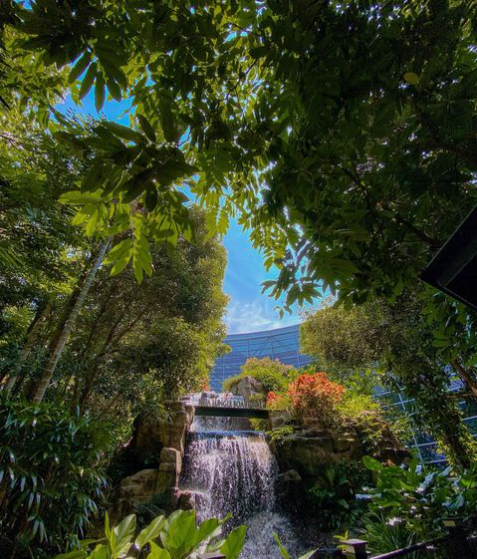To build "[a] airport in the forest, and [a] forest in the airport", a Jungle Broadwalk was created inside the Kuala Lumpur International Airport (KLIA) between 2004 and 2009. KLIA is one of the world's largest airport sites, spanning over 100 square kilometres of land, and it is located in the Malaysian state of Selangor. The Jungle Boardwalk is a miniature tropical rainforest, recreated inside the airport grounds between the main terminal building and the contact pier, and in the central garden in the centre of each satellite building. Though the airport is functioning since 1998, the Jungle Boardwalk was implemented only in 2004 and is home to 3,660 trees of more than 39 species, serving almost 14 mils. passengers every year. The mini forest is home to an impressive variety of trees such as the Medang, Kelat, Tukas and Penaga lilin trees that are indigenous to Malaysia. The intervention provides many benefits such as a cooling temperature level inside the airport, a space for passengers to decompress, and an exploration of the relationship between nature and humans. This project creates a miniature Indonesian rainforest inside the airport to keep alive the heritage of the country's nature. The implementer had in mind "the vision to share a piece of Mother Nature’s tropical heritage with our passengers through the refreshing experience of walking through our natural forest reserve.” This and the fact that the airport is Green Globe Certified makes the intervention unique. (1,2,3,4)
Overview
Nature-based solution
- Nature in buildings (indoor)
- Atriums/Courtyards
- Parks and urban forests
- Green corridors and green belts
Key challenges
- Green space, habitats and biodiversity (SDG 15)
- Habitat and biodiversity conservation
- Green space creation and/or management
- Health and well-being (SDG 3)
- Creation of opportunities for recreation
Focus
Project objectives
Implementation activities
Biodiversity conservation or restoration-focused activities
Biodiversity conservation:
- Protect and enhance urban habitats
- Preserve and strengthen existing habitats and ecosystems
- Protect species
- Undertake specific measures to protect native species
- Means for conservation governance
- Raise public awareness
Main beneficiaries
- National-level government
- Private sector/Corporate/Company
- Citizens or community groups
Governance
Management set-up
- Government-led
Type of initiating organisation
- National government
Participatory approaches/ community involvement
- Unknown
Details on the roles of the organisations involved in the project
Project implemented in response to ...
Financing
Total cost
Source(s) of funding
- Public national budget
Type of funding
- Direct funding (grants, subsidies, or self-financed projects by private entities)
Non-financial contribution
Impacts and Monitoring
Environmental impacts
- Climate change
- Lowered local temperature
- Energy efficiency improvements
- Environmental quality
- Reduced noise exposure
- Green space and habitat
- Increased green space area
- Increased number of species present
Economic impacts
- Attraction of business and investment
Socio-cultural impacts
- Health and wellbeing
- Gain in activities for recreation and exercise
- Cultural heritage and sense of place
- Promotion of cultural diversity
- Improvement in people’s connection to nature
Type of reported impacts
Presence of formal monitoring system
Presence of indicators used in reporting
Presence of monitoring/ evaluation reports
Availability of a web-based monitoring tool
References
2. China Global Television Network (CGTN) (2019), Forest Inside Airport: Travellers can stroll around jungle boardwalk in Kuala Lumpur airport, available at Source link (accessed 23-1-2023)
3. Runaway Bella (no date), Visit KLIA’s hidden Jungle that is helping to preserve Malaysia’s rainforest, available at Source link (accessed 23-1-2023)
4. The Moodie Davitt Report (2016), Vibrant new shopping experience at KLIA, available at Source link (accessed 23-1-2023)
5. Tony Hwijaya (2011), Environmental Response 2: Kuala Lumpur International Airport, Malaysia, available at Source link (accessed 26-03-2023)
6. Rashvellu (2011), The introduction of Kuala Lumpur International Airport ( KLIA ), available at Source link (accessed 26-03-2023)
7. Malaysia Airports Holdings Berhad (2007), Annual Report 2007, available at Source link (accessed 23-1-2023)
8. Ministry of Land, Infrastructure, Transport and Tourism, JAPAN (MLIT) (no date), Malaysia, available at Source link (accessed 26-03-2023)
9. Kisho, K., Dennis, Sharp., Catherine, S. and Tomio O. (1999) Kisho Kurokawa: Kuala Lumpur International Airport. Available at Source link (accessed on 23-1-2023)
10. Malaysia Airports (2011), Clear Horizons, Our Third Sustainability Report, available at Source link (accessed 30-03-2023)
11. Green Airports (2014), available at Source link (accessed 30-03-2023)





